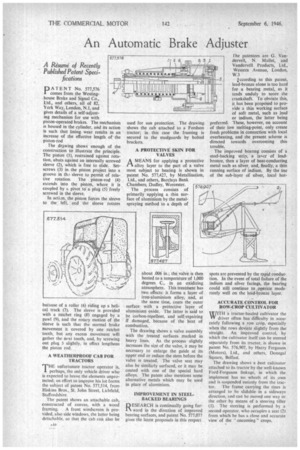An Automatic Brake Adjuster
Page 48

If you've noticed an error in this article please click here to report it so we can fix it.
A Resume of Recently Published Patent Specifications PATENT No. 577,576 comes from the Westinghouse Brake and Signal Co., Ltd., and others, all of 82, York Way, London, N.I, and gives details of a self-adjusting mechanism for use with piston-operated brakes. The mechanism is housed in the cylinder, and its action is such that lining wear results in an increase of the effective length of the piston-rod
The drawing shows enough of the construction to illustrate the principle. The piston (1), restrained against rotation, abuts against an internally screwed sleeve (2), which is free to slide. Setscrews (3) in the piston project into a groove in thf sleeve to permit of rela tive rotation. 1 he piston-rod (4) extends into the piston, where it is coupled by a pivot to a plug (5) freely screwed in the sleeve.
In action, the piston forces the sleeve to the left, and the sleeve rotates beeause of a roller (6) riding up a helical track (7). The sleeve is provided with a ratchet ring (8) engaged by a pawl (9), and the rotary motion of the sleeve is such that the normal brake movement it; covered by one ratchet • tooth, but any excess movement will gather the next tooth, and, by screwing out plug 5 slightly, in effect lengthens the piston rod.
A WEATHERPROOF CAB FOR TRACTORS
THE unfortunate tractor operator is, perhaps, the only vehicle driver who is expected to brave the elements unprotected; an effort to improve his lot forms the subject of patent No. 577,514, from Hiskins Bros., St. John Street, Lichfield, Staffordshire.
The patent shows an attachable cab, constructed of canvas, with a wood
framing. A front windscreen is provided, also side windows, the latter being detachable, so that the cab can also be
used for sun protection. The drawing shows the cab attached to a Fordson tractor; in this case the framing is secured to the mudguards by bolted brackets.
A PROTECTIVE SKIN FOR VALVES
A MEANS for applying a protective alloy layer to the part of a valve most subject to heating is shown in patent No. 577,427, by Metallisation, Ltd., and others, Barclays Bank Chambers, Dudley, Worcester. The process consists of primarily applying a thin surface of aluminium by the metalspraying method to a depth of
about .006 in.; the valve is then heated to a temperature of 1,000 degrees C., in an oxidizing atmosphere. This treatment has two effects: it forms a layer of iron-aluminium alloy, and, at the same time, coats the outer surface with a protective layer of aluminium oxide. The latter is said to be carbon-repellent, and self-repairing if damaged, because of the heat of combustion.
The drawing shows a valve assembly with the treated surfaces marked in heavy lines. As the process slightly increases the size of the valve, it may be necessary to enlarge the guide at its upper end or reduce the stem before the valve is treated. The valve seat may also be similarly surfaced, or it may be coated with one of the special hard alloys. The patent also mentions some alternative metals which may be used in place of aluminium.
IMPROVEMENT IN STEELBACKED BEARINGS
D ESEARCH is continually going forIX ward in the direction of improved bearing surfaces, and patent No. 577,077 gives the latest proposals in this respect Fhe patentees are G. Vandervell, N. Mallet, and Vandervell Products, Ltd., Western Avenue, London, W.3 ,Iccording to this patent, lead-bronze alone is too hard for a bearing metal, as it tends unduly to score the crankshaft. To obviate this, it has been proposed to provide a thin working surface of soft metal, such as lead or indium, the latter being preferred. These, however, on account of their low melting-point, only create fresh problems in connection with local overheating, and the present scheme is directed towards overcoming this trouble.
The improved bearing consists of a steel-backing strip, a laver of leadbronze, then a layer of heat-conducting metal such as silver, and, finally, a thin running surface of indium. By the use of the sub-layer of silver, local hot spots arc prevented by the rapid conduction. In the event of total failure of the indium and silver facings, the bearing could still continue to operate mode• rate)/ well on the lead-bronze layer:
ACCURATE CONTROL FOR ROW-CROP CULTIVATOR
WITH a tractor-hauled cultivator the VV driver often has difficulty in accurately following a row crop, especially when the rows deviate slightly from the straight. An improved control, by which the cultivator itself can be steered separately from its tractor, is shown in patent No. 576,907, by Harry Ferguson (Motors), Ltd., and others, Donegal Square, Belfast.
The drawing shows a beet cultivator attached to its tractor by the well-known Ford-Ferguson linkage, in which the implement has no wheels of its own and is suspended entirely from the trac tor. The frame carrying the tines is arranged to be slidable in a sideways direction, and can be moved one way or the other by means of a steering tiller (I). The steering is performed by a second operator, who occupies a seat (2) from which he has a close and accurate view of the "oncoming" crops.




































































